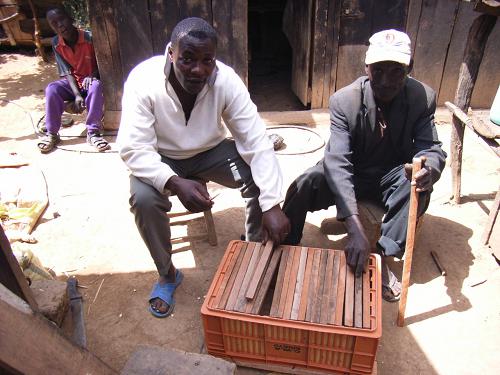Jasper Mbae Kirika & Flora Njeri Namu
Other projects
14 Jan 2010
To Enhance Integrated Community Conservation of Biodiversity in Agro-Ecosystems Adjacent to the Eastern Side of Mount Kenya Forest, Kenya
This project aims to promote conservation of agro-ecosystem biodiversity through documentation, environmental education, planting trees and introduction of bee keeping.

Trees in a nursery ready for planting.
The agricultural landscapes adjacent to eastern Mt. Kenya forest has steep slopes, numerous river valleys and streams. Tea, coffee and food crops growing up to the riverbanks have lead to clear-cutting of natural vegetation resulting in drying up of some streams, soil erosion and massive landslides. The fate of aquatic life, insects, birds and other species whose natural habitats have been destroyed is unknown, yet some of these species are important pollinators and dispersers. This has also increased pressure on Mount Kenya forest for fuel-wood and other forest resources.

Teaching members of the community to construct the hybrid beehives
To promote conservation of these species as well as restore ecosystem processes and functions the following activities will be carried out:
Species documentation
Surveys in different habitats: along rivers and streams, woodlands and bush lands, farms under food and cash crops will be carried out by a team of scientists (ornithologist, mammologists, entomologist, ichthyologist and herpetologists). Surveys will be carried out in the wet and dry seasons. Food sources, nesting and breeding sites for different animal groups will be recorded to determine which plants need to be replanted and the sites that require protection. A team from the community will be trained on sampling and identification of indicator species.
Environmental education
Easy to read and understand brochures in the local language (Kimeru) will be produced in addition to meetings with local community groups and schools; explaining importance of biodiversity in agricultural areas and the need for conservation.
Community bee keeping
A survey will be carried out to determine the number of bee farmers in the area and the problems they are facing with a view to introducing modern bee farming in the area as an incentive to protecting natural habitats.
Tree nurseries
Tree nurseries will be started in schools and with local community groups. In addition to fuel wood, priority will be given to trees and plants found crucial to different animal groups during species documentation. Seeds for nurseries will be acquired through the forestry department.
We hope by the end of this project, to start a long-term monitoring around Mount Kenya forest in order to conserve biodiversity both in the forest and adjacent agricultural landscapes. The monitoring will guide agriculturalists in making decisions and policies regarding biodiversity in the agro-ecosystems.